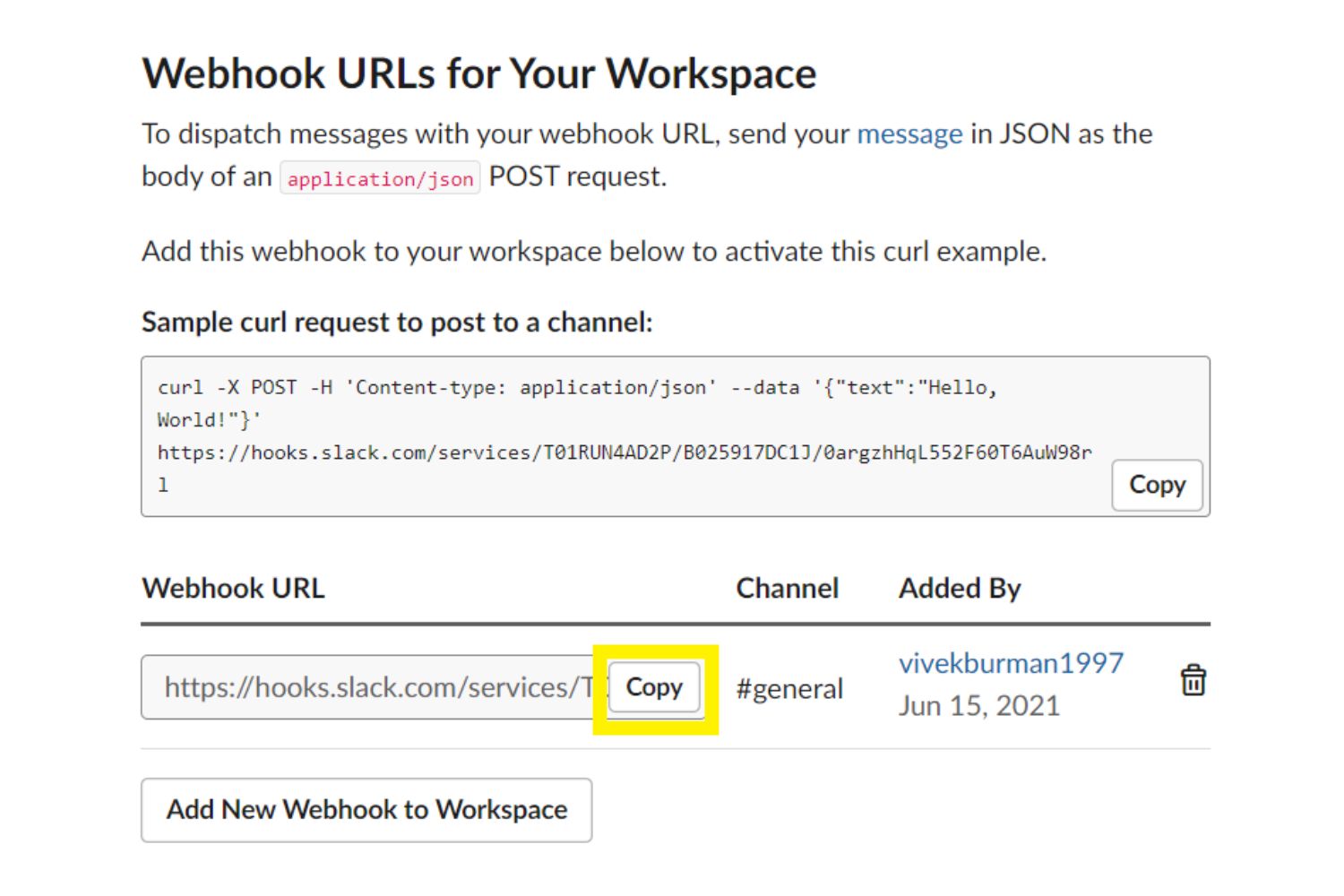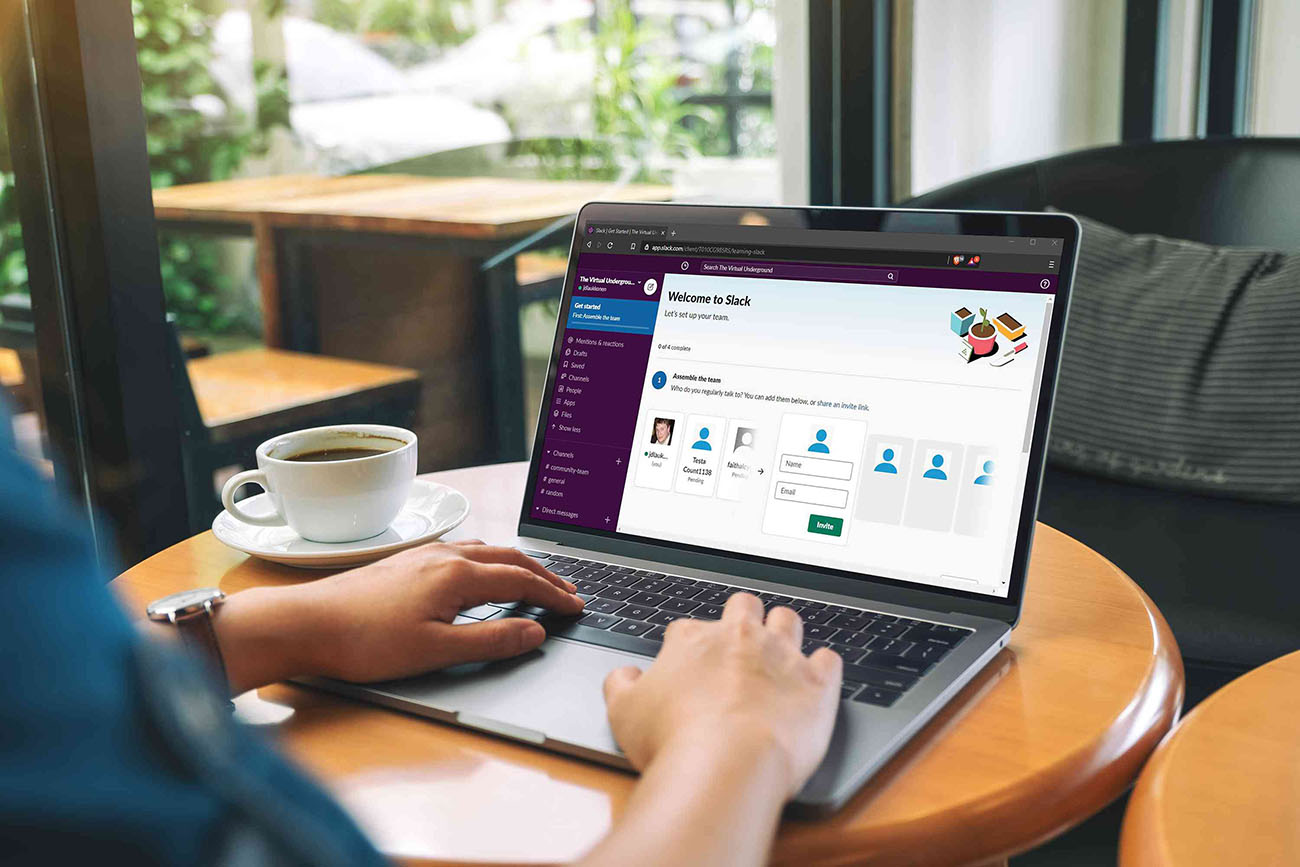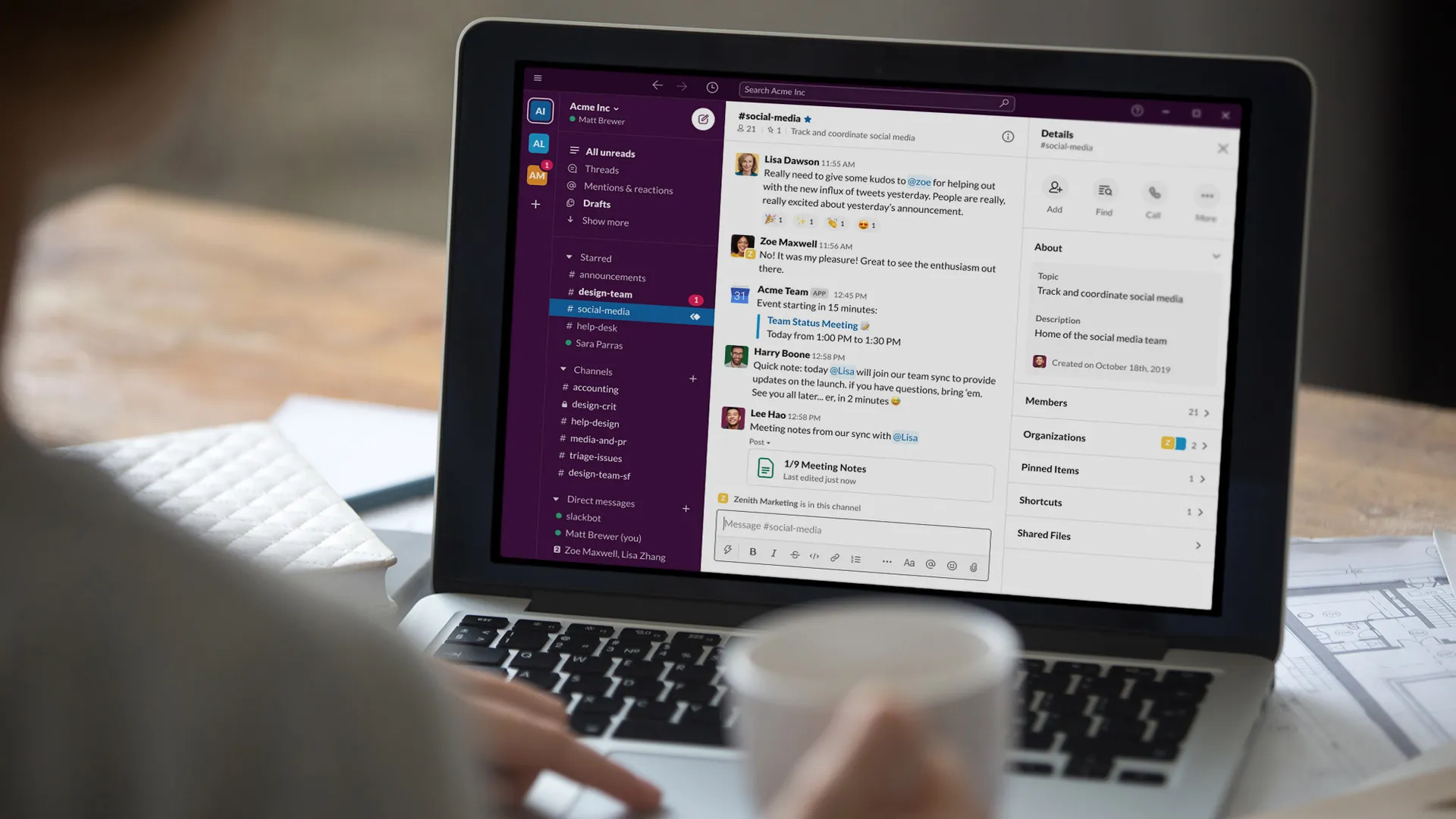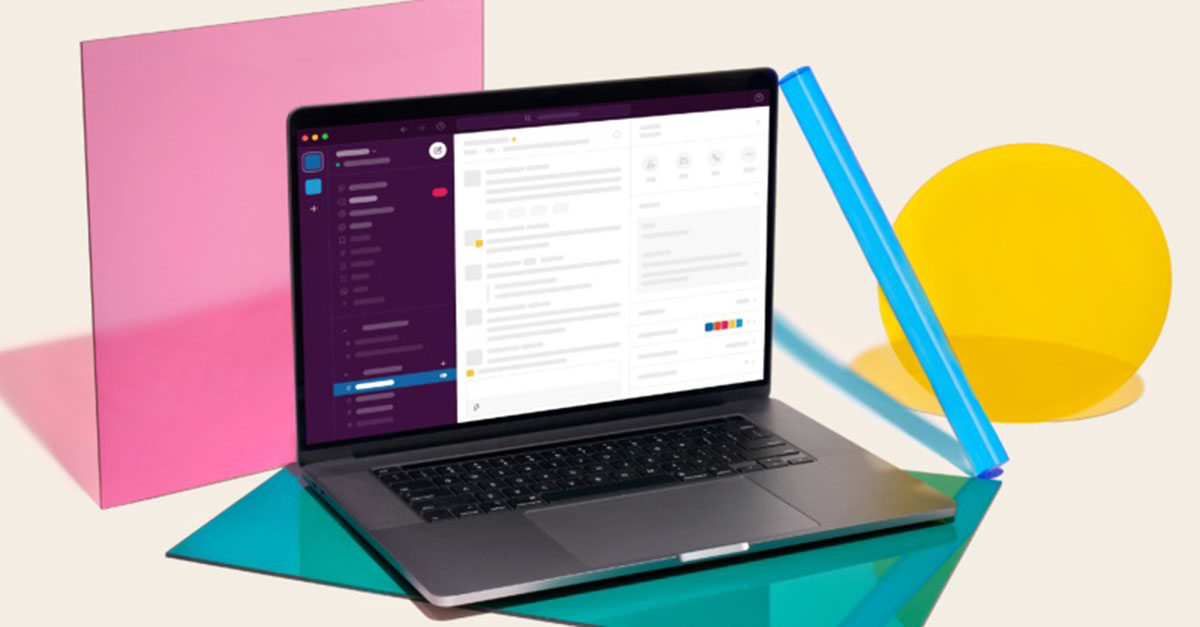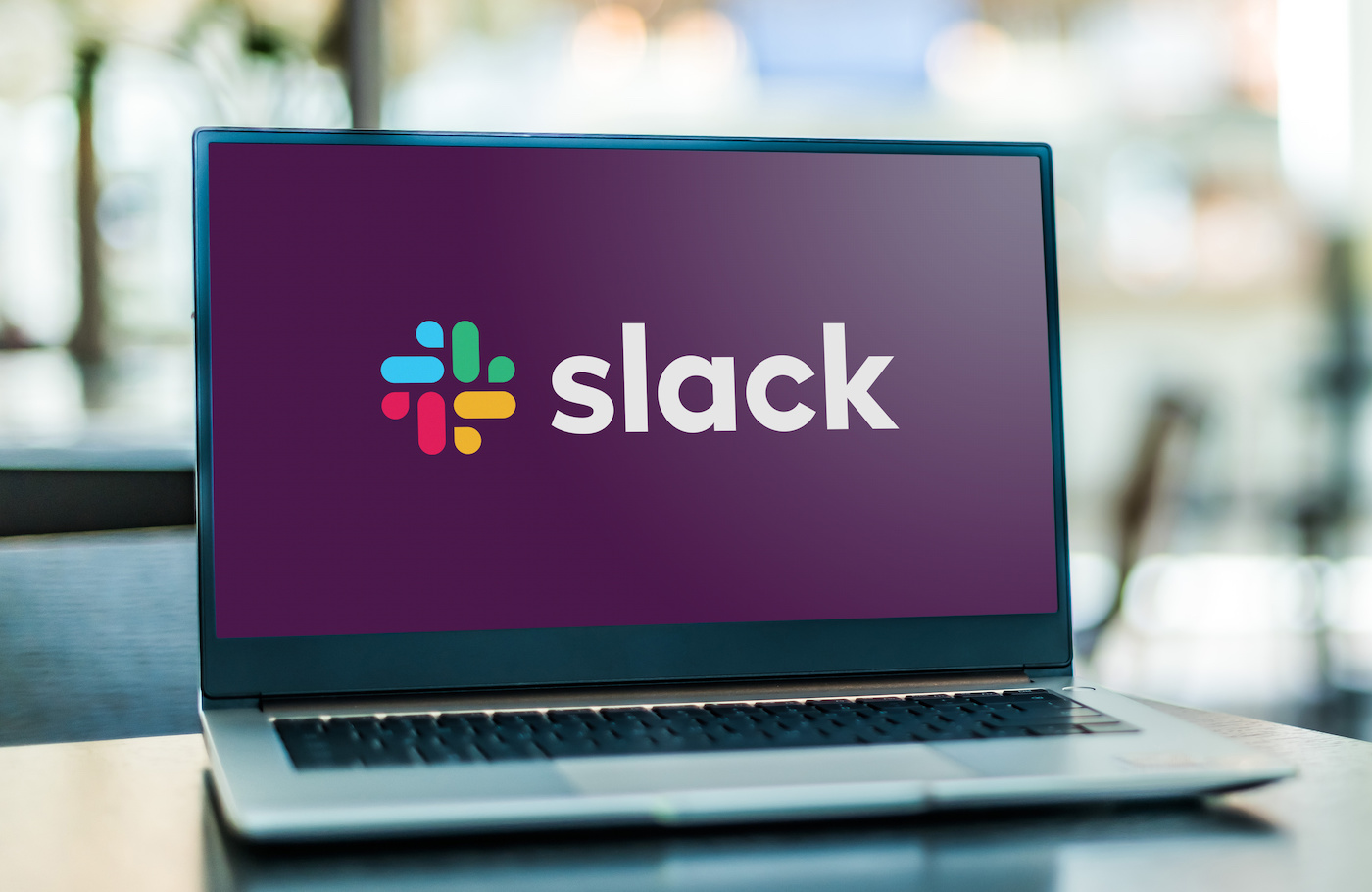Introduction
Welcome to the fascinating world of Slack! If you are part of a team or organization that heavily relies on effective communication and collaboration, then you have likely experienced the challenges of managing multiple conversations, updates, and projects all at once. This is where Slack comes to the rescue. But what exactly is Slack and how can it help streamline your team’s communication?
Slack is a powerful team messaging and collaboration platform that allows individuals and teams to communicate, share files, and collaborate effectively in a centralized and organized manner. With its user-friendly interface and robust features, it has become the go-to solution for businesses, startups, and even non-profit organizations.
One of Slack’s most valuable features is its channels. Channels are where the magic happens in Slack. They are virtual spaces where teams can gather to discuss specific topics, projects, or departments. Channels make it easy to keep conversations organized and allow team members to join or leave based on their involvement and interest. But what exactly is a Slack channel and how can it benefit your team?
What is a Slack Channel?
A Slack channel is a dedicated space within the Slack platform where team members can communicate and collaborate on specific topics, projects, or areas of interest. It serves as a centralized hub for discussions, file sharing, and updates, providing a focused environment for team members to interact.
Think of a Slack channel as a virtual room where team members can gather to have conversations, share ideas, ask questions, and provide updates without cluttering other communication channels like email or instant messaging. It ensures that relevant discussions and information are easily accessible by the right people, fostering transparency and productivity within the team.
What is Slack?
Slack is a cloud-based collaboration platform that aims to revolutionize the way teams communicate and work together. Whether your team is in the same office or spread across different locations, Slack provides a centralized space for effective communication, file sharing, and project management.
At its core, Slack is a messaging app that allows team members to send and receive messages in real-time. But it goes far beyond simple messaging. Slack integrates with various tools and services, such as Google Drive, Dropbox, Trello, and more, making it easy to share files, collaborate on documents, and track progress without leaving the platform.
One of the key features that sets Slack apart is its ability to organize conversations into channels. Channels can be created for different teams, projects, or topics, and team members can join or leave them based on their relevance. This helps to streamline communication by reducing noise and ensuring that conversations are focused and accessible to the right people.
Slack also offers a wide range of features to enhance collaboration within teams. Users can create and assign tasks, set reminders and deadlines, and integrate with project management tools to track progress. Additionally, Slack supports voice and video calls, allowing for seamless communication even when team members are not in the same physical location.
Furthermore, Slack integrates with numerous external apps and services through its app directory. This means you can bring in data and notifications from other tools into Slack, creating a unified and streamlined working environment. With hundreds of apps available, you can customize Slack to fit your team’s specific needs and preferences.
In summary, Slack is a comprehensive collaboration platform that combines messaging, file sharing, project management, and integration capabilities. Its user-friendly interface and robust features make it an invaluable tool for teams of all sizes and industries, enabling efficient communication, collaboration, and productivity.
Channels in Slack
Channels are a fundamental feature of Slack that help organize and streamline communication within teams. They serve as dedicated spaces for specific topics, projects, or departments, allowing team members to have focused discussions and share relevant information.
When it comes to channels in Slack, there are two main types: public channels and private channels.
Public Channels
Public channels are visible and accessible to all members of a Slack workspace. They are designed for open discussions and collaboration among team members. Public channels are ideal for sharing announcements, updates, and general discussions that are relevant to the entire team.
Public channels also foster transparency within the team, as conversations are open for everyone to see. This encourages knowledge sharing and cross-team collaboration, as team members can join channels outside of their immediate focus to stay informed and contribute if needed.
Private Channels
Private channels, on the other hand, are restricted to specific members within a Slack workspace. They are ideal for sensitive discussions, confidential projects, or topics that require a more limited audience. Only invited members can view and participate in private channels.
With private channels, team members can have focused discussions without the risk of sensitive information being exposed to the entire team. This is particularly useful when working on projects involving a specific group of individuals or when discussing confidential matters that require a higher level of privacy.
It is important to note that private channels can only be seen and joined by those who have been invited. This ensures that conversations and files shared within these channels are kept confidential and visible only to the relevant members.
Direct Messages vs. Slack Channels
While direct messages in Slack enable private one-on-one conversations, channels provide a collaborative environment for team-wide discussions. Direct messages are useful for individual conversations or quick exchanges, whereas channels offer a platform for group interactions, updates, and file sharing.
Channels in Slack help to organize and structure team communication by bringing related discussions and topics together. They enable focused collaboration, easy access to information, and increased transparency within the team.
Next, let’s explore how to effectively create and manage Slack channels for optimal team collaboration and productivity.
What is a Slack Channel?
A Slack channel is a dedicated space within the Slack platform where team members can communicate and collaborate on specific topics, projects, or areas of interest. It serves as a centralized hub for discussions, file sharing, and updates, providing a focused environment for team members to interact.
Think of a Slack channel as a virtual room where team members can gather to have conversations, share ideas, ask questions, and provide updates without cluttering other communication channels like email or instant messaging. It ensures that relevant discussions and information are easily accessible by the right people, fostering transparency and productivity within the team.
Channels in Slack can be created for various purposes, such as departments, projects, specific topics, or even social interactions. They can be customized with names, descriptions, and even emojis to reflect the nature and purpose of the channel.
When a channel is created, it becomes a space where all relevant discussions and conversations related to its topic can take place. Team members can join or leave channels based on their involvement or interest, ensuring that they remain actively engaged in discussions that are relevant to them.
One of the key advantages of Slack channels is that they eliminate the need for excessive email threads or long chains of messages in other communication tools. By organizing discussions into channels, team members can easily find and refer back to information shared in the past. This helps to reduce information overload and makes it easier for team members to stay updated on ongoing discussions.
Channels in Slack also support various types of communication, such as text-based messages, file sharing, and even voice or video calls. This flexibility allows team members to choose the most appropriate format for their communication needs, ensuring efficient collaboration and seamless information sharing.
Furthermore, channels can be integrated with other apps and services, enabling seamless collaboration across different platforms. This integration capability allows team members to receive notifications, updates, and even automated reports directly within the channel, eliminating the need to switch between multiple tools and platforms.
In summary, a Slack channel is a dedicated space within Slack that allows team members to communicate, collaborate, and share information on specific topics, projects, or areas of interest. It provides a focused environment for discussions and updates, helping teams streamline their communication and stay organized.
Creating a Slack Channel
Creating a Slack channel is a straightforward process that allows you to set up a dedicated space for team communication and collaboration. Here’s a step-by-step guide to creating a Slack channel:
- Open the Slack workspace where you want to create the channel. You can do this by signing in to your Slack account or accessing the Slack app on your desktop or mobile device.
- In the Slack interface, locate the sidebar on the left-hand side. At the bottom of the sidebar, you will find the option to “+ Add a channel”. Click on this option to begin creating a new channel.
- A pop-up window will appear, prompting you to provide a name for your new Slack channel. This name should be clear, concise, and descriptive of the purpose or topic of the channel. You can also add an optional channel purpose, which helps provide additional context to team members.
- Select the privacy settings for the channel. You can choose between creating a public channel that is visible and accessible to all members of the workspace, or a private channel that restricts access to invited members only.
- Click on the “Create Channel” button to finalize the creation of the new Slack channel.
Once you have created the Slack channel, it will appear in the sidebar alongside other existing channels. Team members can easily view and join the channel based on their interest or relevance to the topic of discussion.
After creating the channel, it’s important to set some basic guidelines and expectations regarding its usage. This includes ensuring that team members understand the purpose of the channel, appropriate behavior, and any specific rules or guidelines that should be followed.
You can also customize the channel by adding a unique emoji to represent it or assigning channel roles to certain members, such as admins or moderators, to help manage and moderate discussions within the channel.
Remember, channels in Slack are not set in stone. If the purpose or relevance of a channel changes over time, you have the flexibility to modify or delete channels as needed. Keeping the channel list organized and streamlined helps to ensure effective communication and collaboration within the team.
Creating Slack channels is a powerful way to organize and structure team communication. By providing dedicated spaces for specific topics or projects, channels help team members collaborate efficiently and ensure that discussions and information remain focused and accessible.
Public Channels
Public channels in Slack are open spaces where team members can join and participate in discussions that are relevant to the entire team. These channels foster transparency, encourage collaboration, and serve as a central hub for sharing announcements, updates, and general discussions.
When creating a public channel, anyone in the Slack workspace can see the channel name, purpose, and message history. This visibility allows team members to easily discover and join channels that align with their interests or areas of expertise.
Public channels are ideal for sharing information and updates that are relevant to the entire team. They provide a platform for open discussions, brainstorming, and collaboration, helping to break down silos and encourage cross-functional knowledge sharing within the organization.
Public channels can be created for specific topics, projects, departments, or even for social interactions and team bonding. By organizing discussions into channels, team members can easily find and refer back to information shared in the past without cluttering other communication channels or relying on lengthy email threads.
One of the benefits of public channels is their inclusive nature. Team members can join and leave public channels as needed, enabling them to stay informed and contribute to discussions that are relevant to their work or area of interest. It also allows new team members to easily get up to speed by joining relevant channels and accessing past conversations.
Public channels in Slack provide a platform for sharing files, documents, and other resources that may be beneficial to the entire team. This eliminates the need for sending attachments via email or using multiple file-sharing platforms and helps keep all team-related materials in one centralized location.
To ensure effective communication and collaboration in public channels, it is essential to have clear guidelines and expectations. Establishing basic rules for behavior, etiquette, and topic relevance can help maintain a healthy and productive discussion environment.
Additionally, public channels can be integrated with external apps and services through Slack’s app directory. This integration capability allows team members to receive notifications, updates, and automated reports directly within the channel, further enhancing collaboration and efficiency.
In summary, public channels in Slack serve as open spaces for team-wide discussions, knowledge sharing, and collaboration. They promote transparency, encourage cross-functional communication, and provide a central hub for sharing information and updates relevant to the entire team.
Private Channels
Private channels in Slack offer a space for confidential discussions, sensitive projects, or topics that require a more limited audience. Unlike public channels, private channels restrict access to invited members only, providing a higher level of privacy and control over who can view and participate in the discussions.
Private channels are beneficial when working on projects involving a specific group of individuals or when discussing confidential matters that require a limited audience. They create a secure environment for focused discussions without the risk of sensitive information being exposed to the entire team.
When creating a private channel, you have the flexibility to handpick the members who are invited to join. This ensures that only those directly involved or with a need-to-know are granted access. Private channels provide a safe space for high-priority discussions, strategy planning, or any other sensitive topics that require a more controlled sharing environment.
By limiting access to invited members, private channels enable more candid and open conversations. Team members may feel more comfortable sharing their thoughts, ideas, and concerns in a private setting, knowing that the discussions remain within the designated group.
Private channels also help to reduce information overload for team members who may not require direct involvement in every discussion. Since the discussions in private channels are specific to the invited members, it prevents unnecessary noise and allows team members to focus on the most relevant information for their responsibilities.
Another benefit of private channels is the ability to discuss and collaborate on sensitive projects or topics without relying on external communication tools or insecure channels. Confidential files, documents, and resources can be shared within the private channel, ensuring secure access and preventing unauthorized individuals from accessing or compromising sensitive information.
It is important to note that private channel conversations and files are not visible or accessible to individuals who have not been invited. This adds an extra layer of security and confidentiality to discussions within private channels.
While private channels provide privacy, it’s essential to maintain transparency and inclusivity within the team. Communicate with the broader team about the existence and purpose of private channels so that members are aware of ongoing projects, discussions, or decisions that may impact their work.
In summary, private channels in Slack offer a secure and confidential space for discussions, projects, and topics that require limited access. They provide control over who can participate in conversations, enabling more candid and focused discussions while ensuring the privacy and security of sensitive information.
Direct Messages vs. Slack Channels
When it comes to communication in Slack, there are two primary methods: direct messages and Slack channels. While both serve the purpose of facilitating conversations and collaboration, there are distinct differences between the two and knowing when to use each is essential for efficient and effective communication within a team.
Direct Messages
Direct messages (DMs) in Slack are private, one-on-one conversations between team members. They are ideal for individual discussions, quick exchanges, or when you need to have a private conversation outside the scope of a Slack channel. Direct messages can be initiated by selecting the person’s name in the sidebar or using the command “/dm [username]” in the message input field.
Direct messages are suitable for situations that require a more personal touch or when confidentiality is necessary. They allow for focused discussions without the distractions of a larger group and provide a space for sharing sensitive or private information.
Some common use cases for direct messages include giving feedback or praise to a team member, having a private conversation with a colleague or supervisor, or discussing confidential matters that should not be shared in a public or private channel.
Slack Channels
Slack channels, as previously discussed, are dedicated spaces for group discussions and collaboration. They are visible to all members of a Slack workspace and can be joined or left based on relevance. Channels can be created for specific projects, departments, or topics of interest.
Channels are ideal for team-wide discussions, sharing updates, and collaborating on projects. They provide transparency, encourage cross-functional communication, and ensure that information is easily accessible to the right people. Channels allow for ongoing conversations, file sharing, and notifications related to a specific topic, project, or area of interest.
Public channels are especially useful for team-wide announcements, general discussions, and knowledge sharing. They enable everyone within the team to contribute, ask questions, and stay informed on relevant topics.
Private channels, on the other hand, cater to more confidential or project-specific discussions. By restricting access to invited members only, private channels provide a secure space for focused collaboration and sharing of sensitive information.
Choosing Between Direct Messages and Channels
Knowing when to use direct messages or Slack channels depends on the nature of the conversation and the audience it involves. Here are some guidelines to help you decide:
- Use direct messages when you need to have a private conversation with an individual or share sensitive information that should not be accessible to others.
- Use Slack channels when the conversation or topic is relevant to a larger audience or team, and when transparency and collaboration are key.
- If a discussion starts in a direct message but evolves into a broader topic that could benefit from team involvement, consider creating a new channel to continue the conversation.
By understanding the differences between direct messages and Slack channels, you can make informed decisions on which communication method is most appropriate for your specific needs. Both direct messages and channels play important roles in facilitating effective collaboration and communication within a Slack workspace.
Using Slack Channels Effectively
Slack channels can be incredibly powerful tools for team communication and collaboration, but their effectiveness relies on utilizing them in the right way. Here are some key tips to help you use Slack channels effectively:
1. Organize Channels Thoughtfully: Take the time to plan and create channels that align with your team’s needs and workflows. Consider the purpose, topic, and audience for each channel, and choose names and descriptions that are clear and descriptive. Organizing channels in a logical and meaningful way will make it easier for team members to find and engage in the right conversations.
2. Establish Channel Guidelines: Set clear guidelines for how channels should be used within your team or organization. Communicate best practices, behavior expectations, and any rules specific to certain channels. This will ensure that everyone understands the purpose, tone, and appropriate use of each channel, fostering a productive and respectful environment for collaboration.
3. Encourage Active Participation: Channels are meant to encourage collaboration and knowledge sharing, so encourage team members to actively participate in discussions. Pose questions, seek input, and invite contributions from all members. This helps to foster engagement and ensures that diverse perspectives are heard and valued within the team.
4. Utilize Threaded Conversations: Slack supports threaded conversations, which allow for more focused discussions within a specific message. Encourage team members to use threads when relevant to keep conversations organized and avoid cluttering the main channel. This ensures that discussions stay on-topic and makes it easier for team members to follow specific threads.
5. Leverage Channel Notifications: Customize your notification settings to ensure that you receive relevant alerts for channels that require your attention, while minimizing distractions for less critical channels. You can choose to be notified for all messages, direct mentions, or specific keywords. By managing your notifications effectively, you can stay updated without being overwhelmed.
6. Keep Channels and Conversations Relevant: Regularly review your channels and conversations to ensure their relevance and usefulness. If a channel becomes obsolete or is no longer actively used, consider archiving or deleting it to maintain a clean and organized workspace. Encourage team members to keep conversations on-topic and relevant to the channel to avoid unnecessary noise and distractions.
7. Utilize Integrations and Apps: Explore the wide array of integrations and apps available in Slack’s app directory. These tools can enhance your team’s productivity and collaboration by bringing data, notifications, and functionality from other tools directly into Slack channels. Integrate project management tools, file storage platforms, or other apps that align with your team’s workflow to streamline processes and access information more efficiently.
By following these tips, you can ensure that Slack channels are used effectively within your team or organization. When channels are well-organized, guidelines are set, and team members actively participate in relevant discussions, Slack becomes a powerful platform for efficient communication and collaboration.
Best Practices for Slack Channels
To maximize the effectiveness and productivity of Slack channels, it is essential to establish and follow best practices. Here are some key guidelines to help you make the most out of your Slack channels:
1. Use Descriptive Channel Names: Give your channels clear and descriptive names that reflect their purpose or topic. This makes it easier for team members to identify and join relevant channels, reducing confusion and ensuring that discussions remain focused.
2. Set Channel Guidelines: Establish clear guidelines for channel usage, including rules for behavior, appropriate content, and expected levels of engagement. Communicate these guidelines to all team members and reinforce them periodically to ensure a consistent and respectful channel environment.
3. Limit the Number of Channels: Avoid creating too many channels to prevent overwhelming team members with an excessive amount of information. Instead, consolidate related discussions into a few key channels, encouraging focused conversation and easier access to relevant information.
4. Promote Channel Discovery: Encourage team members to explore and join channels that are relevant to their work or interests. Regularly communicate the availability of channels and their purpose to ensure that everyone is aware of the resources available for collaboration and knowledge sharing.
5. Encourage Active Participation: Foster an environment where team members feel comfortable and encouraged to actively participate in channel discussions. Pose questions, seek input, and acknowledge contributions to create a dynamic and engaging channel atmosphere.
6. Use Threading for Diverse Discussions: When a discussion within a channel becomes more specialized or off-topic, encourage team members to start a threaded conversation. Threading allows multiple conversations to occur simultaneously within a single channel, keeping the main conversation focused while enabling deeper exploration of related topics.
7. Keep Channels Organized: Regularly review and organize channels to maintain a clean and structured workspace. Archive or delete channels that are no longer active or relevant, and encourage team members to keep conversations and files organized within their respective channels.
8. Utilize Channel Notifications Strategically: Customize your notification settings to receive relevant updates while minimizing distractions. Tailor your preferences based on the importance and urgency of each channel to ensure you stay informed without being overwhelmed by constant notifications.
9. Encourage Channel Etiquette and Respectful Communication: Foster a culture of respect and professionalism within your channels. Encourage team members to be mindful of their language and tone, and remind them of the importance of listening, acknowledging others’ contributions, and avoiding personal attacks or offensive behavior.
10. Regularly Evaluate Channel Effectiveness: Assess the efficiency and engagement levels of your channels periodically. Solicit feedback from team members, measure the level of participation, and make adjustments when necessary. Ensure that the channels continue to serve their intended purposes and meet the evolving needs of your team.
By following these best practices, you can create a productive and collaborative environment within your Slack channels. Effective channel management fosters meaningful discussions, enhances knowledge sharing, and promotes team cohesion, ultimately leading to increased productivity and success.
Conclusion
Slack channels offer a powerful way to streamline team communication, collaboration, and knowledge sharing within organizations. By creating dedicated spaces for discussions around specific topics, projects, or departments, teams can enjoy enhanced transparency, improved organization, and increased productivity.
With public channels, team members can engage in open conversations, share updates, and collaborate on team-wide initiatives. Public channels promote transparency, encourage cross-functional collaboration, and ensure that relevant information reaches the entire team.
Private channels, on the other hand, provide a secure environment for confidential discussions, sensitive projects, or topics that require limited access. Invited members can collaborate, share sensitive information, and work on projects without compromising privacy or security.
By using channels and direct messages appropriately, teams can strike a balance between one-on-one discussions and group collaboration. Direct messages enable private conversations, while channels foster teamwork and ensure that relevant discussions are accessible to the appropriate team members.
To use Slack channels effectively, it is important to follow best practices. This includes organizing channels thoughtfully, setting clear guidelines for usage, encouraging active participation, and leveraging integrations and apps that enhance productivity and collaboration.
Regularly evaluating the effectiveness of channels, keeping them organized, and promoting respectful communication and collaboration are also crucial to ensuring a productive and inclusive channel experience for all team members.
With these practices in place, Slack channels can significantly improve team communication, streamline workflows, and enhance overall productivity.
So, whether you are part of a small startup or a large enterprise, embracing the power of Slack channels can transform the way your team collaborates, leading to greater efficiency, stronger teamwork, and better outcomes.










